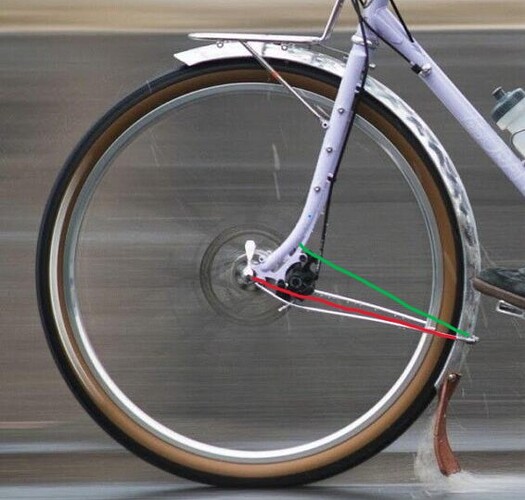I think their design is smarter than mine 
Velo Orange has a nice article on fender utility: This Is Why You Need Fenders - a Spray Analysis – Velo Orange
The Ass Savers Win Wing also seems to try and tackle the ideal minimal fender location https://ass-savers.com/collections/win-wing
I think 10:00-12:00 on the rear and 9:00-11:00 on the front? My thought model is using the tangent of the wheel to predict where the water will come off.
3 Likes
For what it’s worth, your design looks way cooler.
Thanks for linking this article. Its a nice visualization, and it brings up a point that I didn’t consider, how speed effects where the water ends up.
1 Like
I build commuter bikes and always install fenders. I like Axiom and SKS, their prices are not crazy and they both make a quality product. Make sure the fenders you buy have stainless hangers, braces and hardware. The plastic hangers and non stainless hardware that comes with cheap fenders are junk.
Try to have the fenders on hand before you commit to mounting locations. The fenders braces should attach to the frame as close the wheel’s axle as possible. Attaching the braces away from the wheel’s axle looks wrong to me and you will have to get creative in order to make it work if they are anywhere else. I ride in the winter and sometimes snow builds up in between the tires and the fenders causing a lot of drag. It’s a good idea to leave a little extra room between the fender and tire (I usually leave 25mm).
I like SKS fenders too mostly because if the price and durability. They are hella ugly though and the installation hardware can be cheap like ya said. I feel like 25mm clearance is way overkill ]. I usually aim for around 10mm. I don’t use fenders on bikes with knobby tyres.
I know a lot of custom bikes end up with metal (alu or stainless) fenders. I’m guessing mostly because they look so much better. Interested to know if people think they are worth the extra price and hassle of install. I’ve never tried a set.
1 Like
I’d agree with this. However with such little coverage I’d probably just go fenderless. I do like a small front fender on the hardtail but that’s as much about protecting the fork uppers as it is about keeping spray out of my eyes.
2 Likes
I think of fenders protecting 3 things: Rider, bike and following rider. Use as much fender as you can to protect those 3 things as you can. From there it’s about weighing options and trade offs of your situation. If you never ride with someone following you, then 9 to 3 on the rear and 7 to 2 on the front is where I would start and then optimize from there. Extra fender doesn’t weigh much and extending to 9 on the rear allows the extra stabilizer.
One thing to think about on the front is to have the stabilizer mount on the fork such that if something hits the bottom of the fender, the fender pulls away from the tire. The Red line shows a stabilizer that will follow an arc that pulls the fender into the tire - especially with the brake caliper there. The Green one will follow an arc that pushes the fender away from the tire and will have a better chance of letting a stick or rock pass without putting the rider over the bars. This is especially important for bikes ridden off road. It’s not foolproof but it helps.
5 Likes
![]()
